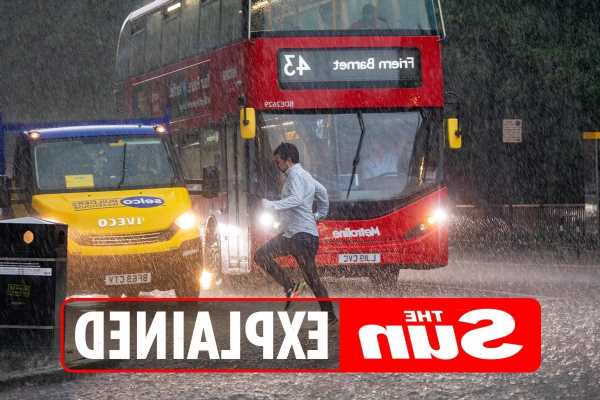PARTS of London has been lashed with torrential rainfall, triggering flooding in residential areas.
The Met Office has issued a yellow warning with more rain expected to be on its way. Here's what we know.
Which areas of London are most at risk of flooding?
According to a 2015 report, around 300,000 homes across multiple boroughs are deemed to be at most risk of flooding from the Thames and the capital’s numerous other rivers.
Areas at risk:
- Hammersmith and Fulham
- Newham,
- Tower Hamlets,
- Barking,
- Dagenham,
- Southwark,
- Greenwich,
- Richmond upon Thames,
- Wandsworth,
- Bexley and Lewisham.
When has London been hit by flash floods before?
- 1928 – The capital was hit by a serious flood as a combination of melting snow, a high tide, and a storm surge caused the Thames river to burst its banks, devastating central London.
- 1953 – During the tragic North Sea Flood, London was just one of the a number of areas affected across the country and across Europe. Water overspilled the Royal Docks and drained into the sewers – flooding Canning Town. One person died as hundreds were made homeless.
- 2013 – 2014 Thousands of people had to be evacuated from their homes after what was considered the stormiest December since 1969. Months later a South Devon railway sea wall carrying the railway linking London with the west of England was washed away by a powerful storm that hit the UK overnight. Thousands of homes were left without electricity
- 2021 – A month's worth of rain poured down in areas of London places in just one hour – with severe flooding wreaking havoc in Raynes Park as cars became submerged in the water.
How can I get flood alerts for London?
The Government has a flood warning information service which will give you an idea of which regions are at risk of flooding.
When has the Thames flooded?
The 1928 Thames flood is the last time the capital's most prominent river burst its banks.
Fourteen people died and thousands were made homeless when floodwaters poured over the over embankments at Southwark, Lambeth, Temple Pier and the Houses of Parliament, where Old Palace Yard and Westminster Hall were quickly flooded.
🔵 Read our London flash floods blog for the very latest updates
Icnonic landmraks including the Houses of Parliament, the Tate Gallery and the Tower of London were surrounded by water.
A Times' correspondent wrote at the time: "It came like a waterfall over the parapet and into the space at the foot of Big Ben."
Along with the disastrous North Flood of 1953 and the political unrest that ensued, the flood helped lead to the implementation of new flood-control measures.
Those plans culminated in the construction of the Thames Barrier in the 1970s.
What is the Thames Barrier?
Opened in 1982, the Thames Barrier is a barrier system designed to prevent Greater London from being flooded by high tides from the North Sea.
It is retractable and is the world's second-largest movable flood barrier,
It is raised (closed) only during high tide at ebb tide it is lowered to release the water which backs up behind it.
Despite global warming, and a higher predicted rate of sea level rise, recent analysis suggested the barrier could last until around 2060–2070.
Source: Read Full Article


